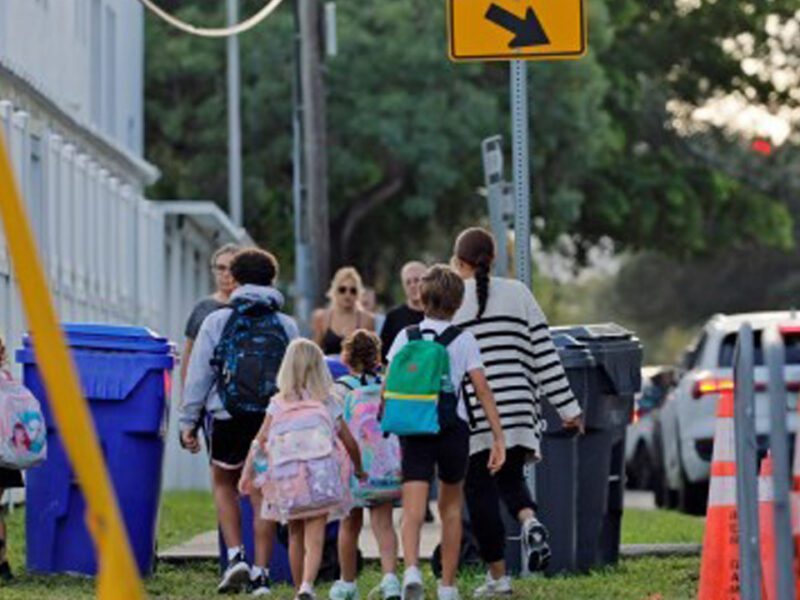Schools Could Count Nonbinary Students Under Biden Proposal
Education Week | By Andrew Ujifusa | November 18, 2021
A blueprint for the federal government’s sweeping collection of data about the nation’s schools would add a “nonbinary option to male/female data categories” in order to ensure that the data “captures accurate and inclusive information about all student identities and student experiences, where the data are available,” the U.S. Department of Education said Thursday.
Other proposed changes to the Education Department’s Civil Rights Data Collection for the 2021-22 academic year would include the gathering of data about preschool discipline, teachers’ experience, and teacher certification.
The proposed 2021-22 Civil Rights Data Collection is due to be published in the Federal Register Nov. 19. The public will then have 60 days to provide comment on the proposal.
The Education Department said that only school districts “that indicate that they collect this information from students would be required to report student enrollment data for nonbinary students.” The department defines “nonbinary students” as those “who do not identify exclusively as male or female,” and said this definition does not apply to transgender students who identify exclusively as either male or female. The National Center for Transgender Equality says that most transgender people are not nonbinary.
Collecting other data about nonbinary students, including experiences of harassment or bullying, would be optional for schools to include in the 2021-22 collection and mandatory thereafter.
Whether schools would make that distinction consistently in information they submit to the department is unclear. And more broadly, the vast majority of school districts might not collect such data, and therefore wouldn’t be prepared to submit accurate data about nonbinary students to the federal government
In addition, such a provision about nonbinary students could turn up the heat on intense political and cultural disagreements about how schools should handle gender-identity and LGBTQ issues.
After a California teacher asked students for their preferred pronouns, for example, a group sought to recall the district’s school board members. Parents have sued a Wisconsin district over a policy that allows students to change their pronouns and names without parental consent. And a lawsuit against a Florida district alleges school officials improperly ignored parents during discussions of students’ gender identity.
Meanwhile, in Washington, the proposal about nonbinary students in the Civil Rights Data Collection might draw fire from Republicans who have been vocal about issues like transgender students who compete in athletic competitions based on their gender identity. A bill introduced recently by Sen. Tom Cotton, R-Ark., for example, would require public schools getting federal funding “to obtain parental consent before facilitating a child’s gender transition in any form, and for other purposes.”
Roughly a quarter of LGBTQ youth—26 percent—identify as nonbinary, according to a recent survey by the Trevor Project, a research and advocacy group. (A Centers for Disease Control and Prevention survey in 2019 found that nearly 2 percent of high school students identify as transgender.)
Because of restrictions for what CRDC data can be made public due to privacy concerns, many if not the vast majority of schools would likely not publicly report the number of nonbinary students, even if they collected such numbers and submitted them, since schools might identify only a handful of them.
But schools’ power to grasp what’s being asked of them and respond with accurate information that might reveal disparities is a key concern in this situation, said Deborah Temkin, a vice president at Child Trends, a research firm that studies issues like poverty, health, and trauma. She noted that it’s unclear how many districts do collect such data on nonbinary students; the information teachers might have about them isn’t necessarily part of schools’ official student records.
“If schools don’t understand what the item is asking, and there are different interpretations across schools, the data becomes difficult to interpret,” Temkin said. “If one school excludes transgender students from the count of nonbinary students, and another doesn’t, the data isn’t comparable. Even when the CRDC has provided clear definitions, schools don’t always refer to them in their submissions.”
More broadly, Temkin said, the option for school districts to include such data could indicate that the Biden administration is interested in having schools ask students and parents directly about children’s gender identity. However, she added, such a move would likely get caught up in heated political disputes.
In June, an Education Department memo said the Biden administration would enforce federal Title IX law, which prohibits discrimination in education on the basis of sex, in order to protect students from discrimination based on their sexual orientation and gender identity. The department cites that interpretation in justifying its change to the CRDC to add data about nonbinary students.
Republicans have said these and similar views of Title IX hurt things like women’s athletics.
Bringing back Obama-era priorities
The civil rights data collection normally occurs every other school year. But last August, the Education Department said it would take place in two consecutive school years for 2020-21 and 2021-22, citing concerns about the negative effects of COVID-19 on students and schools.
The proposed Civil Rights Data Collection would also, for the first time, gather information from schools about “the number of harassment or bullying allegations reported by students on the basis of gender identity.” (Information the department requests in the CRDC for the first time is often optional for schools to submit.)
In addition, the CRDC would reinstate questions eliminated by the Trump administration in the last collection about schools’ share of teachers who are in their first or second year—a statistic that many considered crucial for students’ educational experiences—as well as racial disparities in preschool discipline by race.
Such disparities in school suspensions and expulsions were a big education issue for the Obama administration. And the Biden administration could revive Obama-era guidance about racial gaps in discipline that the Trump administration revoked.
The proposal would also seek data about “the number of documented incidents of school shootings, regardless of whether anyone was hurt; and the number of documented incidents of homicides that occurred at the school.”
This could in part represent an attempt by the department to improve the quality of previous CRDC data about school shootings. In the past, information schools submitted about these incidents has proven to be fundamentally flawed, a fact that has underscored broader worries about the accuracy of the information schools submit in the CRDC concerning issues like school desegregation.
There are indications that school violence is on the rise this year, although there’s a lot of dispute as to why that might be happening.
In the context of COVID-19, the CRDC proposal would seek information related to the pandemic about the extent to which schools are offering in-person or virtual instruction. More than 99 percent of public school students were learning in person in late October and early November, according to data published by the Education Department that covers 89 percent of students.






